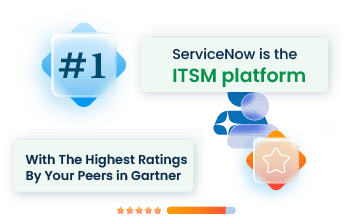“Navigating daily business operations can be a maze of disconnected systems, slow processes, and repetitive tasks. Your team spends hours manually transferring data between platforms, leading to errors and inefficiencies.
ServiceNow Integration Hub solves these challenges by connecting systems and automating workflows, reducing manual effort and minimizing errors. Automated data transfer between your CRM and ERP systems ensures real-time updates without manual intervention.This integration directly impacts your business workflow by improving accuracy, saving time, and allowing your team to focus on strategic tasks instead of routine data handling.
What is ServiceNow Integration Hub?
ServiceNow Integration Hub connects various systems and automates workflows using standard protocols like APIs, JDBC, and PowerShell. It allows seamless interaction with external platforms, providing a unified interface for managing integrations within the ServiceNow ecosystem. By centralizing integrations, it enhances operational efficiency, helping organizations maintain consistency and accuracy in their workflows. Integration Hub simplifies complex integrations through a user-friendly interface, reducing the time and effort needed to connect systems.
It supports real-time data synchronization, ensuring up-to-date information across all platforms. This capability transforms how businesses manage data, making operations smoother and more reliable.
Choosing the Right Integration Approach
When selecting an integration approach, it’s crucial to consider various strategies tailored to your specific needs. ServiceNow Integration Hub offers several methods to connect systems and automate workflows.
1. Prebuilt Spokes: Ideal for common integrations, these ready-made connectors save time and minimize errors.
2. Custom Spokes: For unique requirements, custom-built spokes provide flexibility. Using Action Designer, you can create powerful, reusable integrations tailored to your needs.
3. Flow Templates: These templates guide you through building integrations, making it easier to add automation to your workflows.
What Does IntegrationHub Include?
IntegrationHub includes a comprehensive suite of features designed to enhance your integration capabilities. These features encompass:
- Pre-built Spokes: Ready-made connectors for popular applications such as Salesforce, Microsoft Teams, and Slack, facilitating seamless integration.
- Custom Spokes: Create tailored integrations for unique business needs.
- Out-of-the-Box Spokes Out-of-the-Box Spokes provide a set of predefined actions and subflows for various applications like Slack, Microsoft Teams, and more.
- Flow Templates offer pre built patterns to streamline integration processes. These templates cover common scenarios, providing a solid starting point.
- Flow Designer: A no-code interface for creating and managing workflows, enabling easy automation of business processes.
- Action Designer: The Action Designer serves as a powerful tool for building custom integrations. It allows for creating reusable actions, ensuring consistency across workflows.
- Connections Dashboard: Real-time monitoring and management of all integrations, ensuring visibility and control.
- API Integrations: Seamlessly connect with various APIs, enabling smooth data flow across systems.
- API Triggers: Capabilities to trigger workflows based on API events, allowing for responsive and dynamic processes.
- Remote Tables: Solutions for integrating data from various platforms without data duplication, maintaining data integrity.
- IntegrationHub Import: Tools for importing data from multiple sources, streamlining data consolidation and analysis.
- Real-time Data Sync: Ensure up-to-date information with real-time synchronization.
- Error Handling: Robust mechanisms for identifying and resolving integration issues.
Benefits of ServiceNow Integration Hub
Efficient Data Handling: Ensuring minimal data redundancy and optimizing data transfer processes keeps the system agile.
Load Balancing: Distributing workloads evenly to prevent any single point of overload.
Monitoring Tools: Using real-time monitoring to identify and resolve performance issues promptly.
Integration Made Easy for Diverse Business Sectors
The ServiceNow Integration Hub low-code/no-code interface simplifies integration, allowing non-technical users to participate in creating workflows. This approach reduces reliance on IT departments, freeing resources for strategic initiatives.
Specific Advantages by Sector
- Healthcare: Ensures secure data exchange between electronic health records and other systems, enhancing patient care coordination.
- Finance: Automates data synchronization between financial systems, improving accuracy and compliance.
- Retail: Integrates inventory management systems with point-of-sale systems, optimizing stock levels and sales processes.
Actionable Steps to Maximize Benefits
- Identify Key Integration Needs: Assess your business processes to determine where integration can provide the most value.
- Utilize Pre-built Templates and Spokes: Start with available templates and spokes to quickly set up integrations.
- Custom Spokes for Unique Needs: Develop custom spokes for specific requirements to tailor the integration to your unique workflows.
Why Use Integration Hub to Automate Platform Integrations with Third Parties?
ServiceNow’s Integration Hub enables seamless connections with a variety of third-party applications such as Salesforce, Jira, Snowflake, and Azure DevOps. This integration facilitates automated workflows, ensuring data flows smoothly across platforms.
Impact of Third-Party Integrations
Integrating ServiceNow with third-party applications offers numerous advantages:
- Enhanced Workflow Efficiency: Automated integrations reduce manual data entry, minimizing errors and saving time. Integrating Jira with ServiceNow synchronizes IT and development workflows, streamlining issue tracking and resolution.
- Real-Time Data Synchronization: Keep your data consistent and up-to-date across all systems. Connecting Snowflake for advanced analytics ensures that insights are based on the latest information, enhancing decision-making accuracy.
- Scalability: Integration Hub handles growing data volumes and complex workflows efficiently. This makes it suitable for large-scale operations where performance and reliability are critical.
- Security: Secure data transfer through encrypted channels protects sensitive information and ensures compliance with industry standards. Integration with Azure DevOps supports robust security measures for continuous delivery and deployment processes.
Setup and Activation of ServiceNow Integration Hub
How to Activate the ServiceNow Integration Hub?
Begin by navigating to the ServiceNow instance and accessing the IntegrationHub module. Within this module, you will find the activation button. Follow these prompts, ensuring that all prerequisites, like correct permissions and access, are in place. Activation may take a few moments, so please be patient.
Step-by-Step Activation Guide
- Go to the ServiceNow instance.
- Access the IntegrationHub module.
- Click the Activation button.
- Follow the on-screen prompts.
- Confirm all prerequisites are met.
Tips for a Smooth Setup Process
- Check Permissions: Ensure you have the necessary permissions.
- Pre-Install Requirements: Verify that all pre-install requirements are fulfilled.
- Network Readiness: Ensure your network setup allows for seamless integration.
Initial Assessment
Begin with a thorough assessment of your current systems and business needs. Evaluate your IT infrastructure, identify pain points, and outline your goals. This step is crucial to understand where ServiceNow can make the most impact.
- Audit Your IT Systems: Conduct a detailed audit of your existing IT systems and workflows.
- Identify Pain Points: List out the specific issues and inefficiencies you are facing.
- Define Objectives: Clearly outline what you hope to achieve with ServiceNow (e.g., improved workflow, better incident management).
How Do I Start Using IntegrationHub?
To get started with IntegrationHub, familiarize yourself with the Flow Designer interface. Begin with a simple flow to understand the basics. Avoid complex flows initially to prevent common pitfalls.
Beginner’s Guide to Getting Started
- Open Flow Designer.
- Create a new flow.
- Add basic actions and triggers.
- Test the flow with simple data.
- Gradually add complexity as you become more comfortable.
Common Pitfalls and How to Avoid Them
- Overcomplicating Early Flows: Start simple and build complexity over time.
- Ignoring Permissions: Always check and set proper permissions for each flow.
Build Your First Spoke
Creating your first spoke involves using the Action Designer. Start by defining the action, setting inputs and outputs, and testing thoroughly.
Tutorial on Building a Spoke from Scratch
- Access Action Designer.
- Define the action you want to create.
- Set the inputs and outputs.
- Test the action with sample data.
- Adjust and finalize the action based on test results.
Best Practices for New Users
Thorough Testing: Always test with various data sets.
Documentation: Keep detailed documentation of each action for future reference.
Best Practices
Adhering to best practices ensures smooth operations and minimizes issues.
Comprehensive List of Best Practices
- Keep Flows Simple: Start with basic flows and add complexity gradually.
- Regular Testing: Conduct regular tests to catch issues early.
- Proper Documentation: Maintain detailed records of all integrations.
Expert Tips for Maximizing Efficiency:
- Modular Approach: Break down complex processes into smaller, manageable tasks.
- Frequent Reviews: Regularly review and update flows to adapt to changes.
Create Workflows Using a Familiar Interface
Use the Flow Designer interface to create workflows. Familiarity with this tool can speed up the process.
Guide on Using Familiar Interfaces for Workflow Creation
- Open Flow Designer.
- Utilize pre-built templates to save time.
- Customize templates to fit specific needs.
Tips for Seamless Integration:
- Utilize Templates: Start with templates and customize as needed.
- Iterative Testing: Test each step to ensure smooth operation.
Easily Connect Workflow Automation with Virtual Agent Designer
Linking workflow automation with Virtual Agent Designer can enhance user interaction.
Tutorial on Connecting Workflow Automation
- Open Virtual Agent Designer.
- Create or edit a bot conversation.
- Link conversation steps to Flow Designer actions.
- Test the entire workflow for smooth operation.
Advanced Tips for Complex Workflows
- Use Subflows: Break down complex workflows into subflows.
- Error Handling: Implement robust error handling in each flow.
Technical Details and Functionalities
IntegrationHub Import Importing data with IntegrationHub follows a straightforward process. You select the source, map data fields, and initiate the import.
REST API Trigger Using REST API triggers, IntegrationHub automates responses to specific events. By configuring these triggers, you can initiate workflows seamlessly.
Remote Tables Remote tables allow data interaction from external sources without data replication. This maintains data integrity and saves storage.
Connections Dashboard The Connections Dashboard provides a centralized view of all integrations. It offers tools for monitoring and troubleshooting. Tips for monitoring and optimizing connections include setting up alerts for failures and regular performance reviews to maintain smooth operations.
Limitations of Integration Hub
The Integration Hub in ServiceNow, while robust, has some areas that could challenge its users. Performance issues may arise with high-volume data transactions, slowing down operations. Limited support for advanced bi-directional integrations means more manual efforts. Additional licensing costs for full functionality can lead to unexpected expenses. Complex configurations for custom integrations often require specialized skills.
To address these issues
- Optimize data workflows to manage high-volume transactions better.
- Use external tools for advanced bi-directional integrations.
- Plan budgets carefully to account for additional licensing costs.
- Invest in training: Consider training options like ServiceNow consulting to help team members manage complex configurations.
Use Cases for ServiceNow Integration Hub
ServiceNow Integration Hub serves as a crucial tool for connecting disparate systems and automating workflows across various platforms.
● Information Technology (IT)
- Integrates with tools like Jira, Slack, and Microsoft Teams.
- Automates ticket updates and notifications.
- Reduces manual efforts, improving incident management.
● Healthcare
- Integrates electronic health record (EHR) systems with ServiceNow.
- Facilitates seamless data exchange.
- Improves patient care coordination.
● Finance
- Connects with payment gateways and compliance tools.
- Automates transactions and regulatory reporting.
- Enhances accuracy and compliance.
● Legacy System Integration
- Supports unique business requirements.
- Facilitates integration of legacy systems with modern cloud services.
- Utilizes custom spokes to address specific challenges without heavy coding.
Conclusion
ServiceNow Integration Hub offers a powerful solution for seamless integration of your business processes. It helps create a unified environment where data flows effortlessly between systems, improving overall performance. With its comprehensive features, businesses can connect various applications and automate workflows without the need for extensive coding.
Think about how this can transform your daily operations and free up valuable time for strategic initiatives.
For personalized guidance and to maximize the benefits of ServiceNow Integration Hub, connect with a ServiceNow consulting expert. They can provide tailored solutions to fit your unique needs. Don’t hesitate to seek a consultation to further explore the possibilities.











